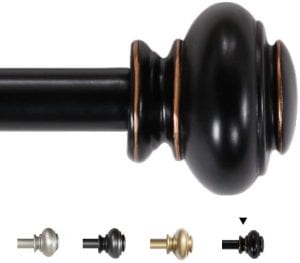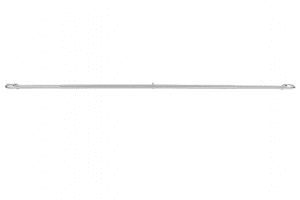The Best Curtain Rods, 100 To 120 Inches

Our Review Process
Don't Waste Your Money is focused on helping you make the best purchasing decision. Our team of experts spends hundreds of hours analyzing, testing, and researching products so you don't have to. Learn more.
Our Picks For The Top Curtain Rods, 100 To 120 inches
- 1. H.VERSAILTEX Wrought Iron Window Curtain Rod, 66-120-Inch
- 2. Kenney Wall-Mounted Metal Curtain Rod, 66-120-Inch
- 3. Amazon Basics Adjustable Length Curtain Rod, 72-144-Inch
- 4. Umbra Easy Install Double Curtain Rod, 88-144-Inch
- 5. Ivilon Telescoping Iron Curtain Rod, 72-144 Inch
- 6. Decopolitan Beme Adjustable Curtain Rod, 72-144-Inch
- 7. KAMANINA Decorative Vintage Curtain Rod, 72-144-Inches
Whether your window curtain is light or heavy, this curtain rod, 100 to 120 inches has you covered. It's length is fully adjustable and the rod itself is made from a durable stainless steel. You will have a choice between a black, nickel or pewter finish, which means you'll be able to select a rod that matches your current decor.
Adjustable LengthYou won't have any trouble fitting this curtain rod in your window, as it is adjustable from 48 to 84 inches.
Give style to your space with this decorative curtain rod, 100 to 120 inches. It features attractive resin finials and is made from a metal that is designed to last. The mounting hardware is included and you'll find the rod is easy to install.
Multiple FinishesYou'll find this curtain rod, 100 to 120 inches comes in a choice of an Old World brass, matte black or oil rubbed bronze finish.
Although these curtain rods, 100 to 120 inches are simple in design, they are also elegant. The rods are constructed from a durable steel and are easy to adjust to fit a variety of window sizes. The round finials on each end of the rods add a touch of style to the pieces.
Easy to InstallEverything you need to hang these curtain rods, 100 to 120 inches is included with your purchase.
These curtain rods, 100 to 120 inches take just a few minutes to set up and come with easy-to-follow instructions. They fit multiple window sizes and can accommodate blackout curtains to save on energy costs. You can even get these rods in a choice of finishes, such as black, nickel, brass and bronze.
Double Rod DesignThanks to the curves on the ends of these curtain rods, 100 to 120 inches, you'll be able to pull your curtains flush with the wall.
Buying Guide
In strictly utilitarian terms, 100- to 120-inch curtain rods are there for support. And if that’s all they were, picking a curtain rod would be easy. After all, you’d just be looking for a relatively sturdy rod of steel or wood, meant to hold up some heavy sheets of fabric.
In reality, a well-chosen curtain rod that’s 100 to 120 inches long can be just as much a component of your decor as the curtains themselves. Get the finials just right and you’ve got a synchronized look that complements not just the curtain but the room around it. Choose poorly and you’ve got a crucial design element that stands out — and not in a good way.
Before you give any thought to style, make sure you get the size and materials right. That will mean spending some time at your window with a tape measure. As a general rule, the edges of your curtain rod should extend 3-6 inches past the window frame on either side. That means your curtain rod should be about 6 inches to a foot bigger than your window. Don’t worry too much about getting one that’s exactly the right measurement. Most rods will either telescope or have a spring-loaded mechanism of some sort that allows you to adjust their length.
You’ll also want to get a curtain rod that’s the right thickness. Anything smaller than one inch in diameter might be too flimsy for your needs, especially with heavier grommet-style curtains or those made of heavy, quilt-like material. But you won’t want to get anything that’s too thick either, especially if you’re using curtains with the common casement mounting style. (That’s a curtain that hangs by way of a pocket sewn into the fabric at the top.)
Of course, some materials might be stronger than others. No matter what your curtain rod is made of, non-telescoping models are generally a little more sturdy — though certainly less versatile. The typical curtain rod will be made of aluminum, stainless steel or some other form of metal, with plastic a less common option. You might also find older curtain rods that are made of wood, which can definitely evoke a classic feel. Metal is the most common material for a reason. It’s durable and if it’s treated properly won’t corrode. Most importantly, it’s less prone to sag under the weight of heavy curtains, though telescoping rods might still bow if they’re stretched too long or improperly installed. Plastic rods are more likely to bend, and wooden rods even more so. What’s more, these bends in the wood can become permanent over time. This can be mitigated by rotating the rod periodically, but if you’re not up for that level of maintenance, a steel curtain rod is your best option.
No matter what type of construction you choose from a durability perspective, you may also want to choose with an eye to style. It’s true that for the most part, it is the curtain and not the curtain rod that will draw the most focus. If your curtain attaches by way of a casement or rod “pocket,” you won’t even see most of the rod at all. The same is true of back tab curtains where attachment loops on the back will hide the rod from the front. On the other hand, if you are hanging grommet curtains, you may want to choose a complementary color or style. Grommet-style curtains hang by way of loops designed to make pleats in the fabric, and this ends up showing a good amount of the curtain rod itself. If you’d like to draw less attention to the rod, it’s best to pick a color that blends into the paint scheme of the wall behind it.
Even if your curtain rod isn’t showing at all, there’s still one important style element to consider: The finial. A finial is a decorative element that sits at the top of any pole. In the case of curtain rods, these are the toppers at either end. They can be ornate, miniature sculptures or simple, functional knobs. In the case of some curtain rods, you can replace the finials to suit your needs.
Finials can be a great accent that enhances the effect of your curtain and the larger room around it. Make sure you match the style to the decor, though. Large formal rooms might call for ornate crystal finials, but maybe not a patio where the rest of the furniture is rattan or some other rustic material. You can easily find finials that match the patterns on a curtain — carved flowers for floral themes, diamond shapes or other geometric shapes for patterns that have that motif. Feel free to have fun in children’s rooms, dens or playrooms by using finials shaped like baseballs, ship’s mastheads or other whimsical items.
What to Look For
- When installing curtains, length is the primary measurement you’ll have to make, but it’s not the only one. During installation, place your curtain rod brackets about 6-8 inches above the top of the window frame. This will help the window and the room itself appear bigger. If low ceilings prevent you from going that high, just get as high as you can without impeding the installation.
- Another note on installation: Make sure your brackets are positioned in a way that doesn’t stop the curtain from opening or closing. In most cases, brackets will go only at the middle of the window and at either end, but with larger windows you may need to get creative.
More to Explore
Samuel Scottron was a man of many passions. The inventor and black rights activist was probably best known in his day for establishing a patent on the curtain rod in 1892, and he’s also credited with inventing the hand strap that trolley passengers hang onto as they ride. These days, he’s probably better known as the great-grandfather of singer and actress Lena Horne.

















